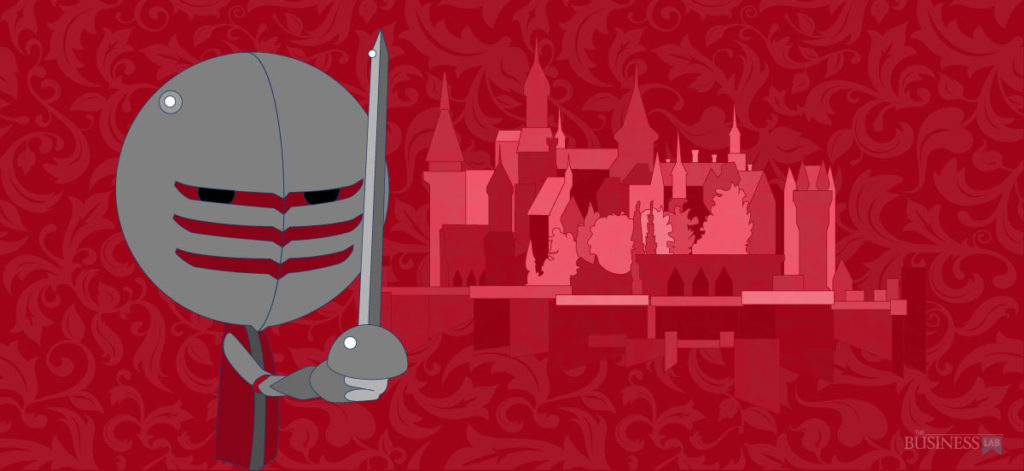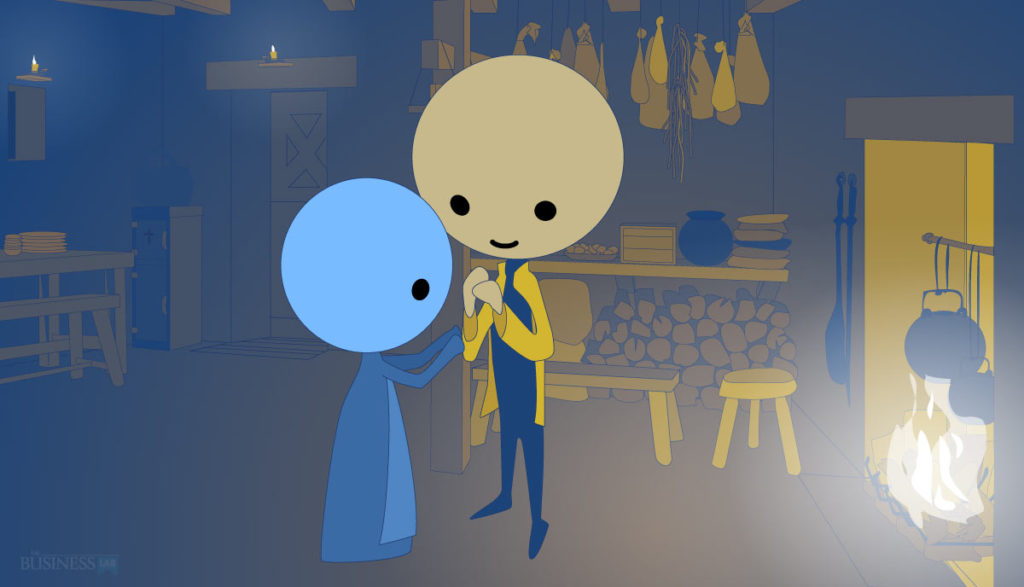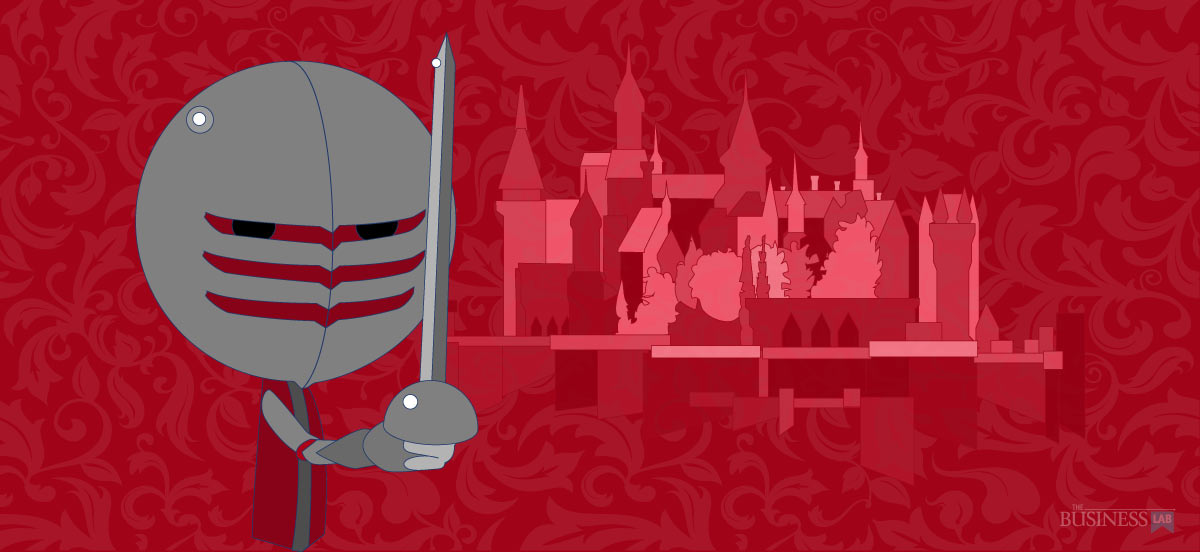
Deep in the forest, far away from most others, a widow governed by fear raises her second son. She is determined to keep this son safe from the fate that took her husband and first child. But, boys will be boys, and at the age of 16, this boy steps across his known threshold and comes upon five knights from the Arthurian court. Now, he’s never heard about or seen anything like these knights, and he is mesmerized. He is now determined to become just like them.
Of course, he has to tell his mother, whose greatest fear is just this. She faints with the news, comes to, and sees his determination. She lets him go but insists he wears the homespun shirt she’s made for him and gives him a set of rules to follow along the way.

After some time of riding in the forest, he finds King Arthur’s castle. He makes his way inside, lands before the king, and asks to be knighted. The king is quite amused until the damsel who has not laughed or smiled in six years bursts out laughing. Legend has it that this girl will only laugh in the presence of the greatest knight the world has ever known. Taking notice of this, King Arthur knights the young man, gives him a Paige, a sword, and tells him that “Adventures make the knight.” And, off he goes.
His first encounter is the Red Knight — the reigning king of knights who is so powerful that he rides into Arthur’s court once a year, throws wine in the queen’s face, and leaves again with no one able to stop him. The young boy doesn’t know this but what he does know is that he wants that red armor this knight is wearing. Upon telling the knight he wants his armor, the knight replies, “Sure, if you can get it.”
The Red Knight doesn’t really want to fight this skinny young boy because he sees it as a waste of time, but the young boy insists. They ride at each other. The young boy falls to the ground but is unhurt. Instinctively he reaches for his dagger throws it at the Red Knight, and it pierces him through the eye, killing him.
The young boy struggles to remove and put on the Red Knight’s armor. His Paige helps him but tells him he should not place this armor over his homespun shirt. The young boy refuses to cast the shirt aside and puts the armor on himself.
Along the way, he finds his way to Gornamont, who teaches him how to be a ‘proper’ knight. Like his mother, Gornamont gives this young boy a set of rules to follow, of which one is “To not ask too many questions; otherwise, you’ll look foolish.”
The young boy sets out to go back and see his mother. Along the way, he meets many adventures and defeats all challengers. He never kills them; instead, he sends them back to serve King Arthur.
One day he finds shelter in the Fisher King’s castle. The Fisher King is the Grail King, and even though he has possession of the Grail, which provides endless abundance, he and his kingdom cannot partake. He has a wound that will not heal. He is in agony but cannot die. His kingdom is a reflection of his inner self and as such, is also in agony. It’s in dire straits — nothing can grow, and nothing can thrive — it is wounded. This is the wasteland.
The people inside are enchanted, and they know they are enchanted. Their lives are in perfect symmetry — they can have different viewpoints, but the situation is always the same. They are deluded and so entrenched in their wasteland, they cannot see the bigger picture. They can only offer cliches of responses. They can only react and cannot create.
Creative acts require a new level of understanding of a relationship to life, others, the landscape, etc. An understanding of what this relationship might be. Creative acts require innovation.
The inability to take creative action is the wasteland—people living only in terms of what has always been, unable to see anything else — enchantment.
As the young boy enters the castle, a ceremony begins. The Fisher King is paraded out, in agony and close to death, but cannot die. The young boy feels the urge to ask about the situation but remembers he is not to ask too many questions and risk looking foolish. He remains silent.
Everyone leaves, the young boy is taken to his room for the night. When he wakes up, his clothes have been washed, and his armor shined, but no one is in sight. He is all alone. He leaves the castle, which evaporates behind him.
Wandering along, he meets a damsel who scolds him and tells him, “A spontaneous question from you would have healed the king and the land.”
It is here that the young boy knows his name for the first time – Percival. For he chooses the middle – of the valley, of a pair of opposites, of everything.
It is here that Percival realizes he has not achieved the heroic task. He’s told that he can never enter that castle again because of his failure. He dismisses this and sets out to right his wrong. He wanders around for five years. During this time, he has found his own way. He realizes he failed his task because he too closely followed the rules given to him — he fell into natural cliches.
He now knows he must shed his mother’s shirt, follow his own heart, intuition, and belief in himself instead of following the herd. He must take creative action, stick his neck out, and go against the norm. He must see things anew with a beginner’s mind.

“A man must consent to look to a foolish, innocent, adolescent part of himself for the cure. The inner fool is the only one who can touch and heal his Fisher King wound.” — Robert A. Johnson
Percival finds his way back to the castle, asks the question, and becomes the Grail King — allowing the Fisher King to die, the land to heal, and the enchantment to be broken.
The proper response to healing wasteland situations is to heal the wound by following one’s own nature; by being authentic. This is what Percival did — he achieved the kingdom through his character, his loyalty, his courage, and his one-pointed resolution. He inherited the kingdom but not the wound.
The Grail and its many benefits are obtained by people who have lived their own lives. It is a symbol of an authentic life. The former Grail King, the Fisher King, was given his position instead of earning the position, and thus the wound.
Nothing can be healed if it remains in the old Fisher King mentality. To be cured, cliche responses and status quo enchantment must give way to something entirely different from what currently is. The beginner’s mind, the inner fool, is what can heal the wound.
“In the beginner’s mind there are many possibilities, in the expert mind, there are few.” — suzuki
For many companies, COVID has forced the issue of giving way to something entirely different from what is. And it’s the companies and mindsets that approach this force with a beginner’s mind, with the courage to look foolish, stick their necks out and create, who will achieve the Grail.
We are in unprecedented times for innovation and growth. Growth and innovation do not come free; they must be earned through adventure. Throughout, leaders will increasingly find themselves in the forest with no clear path and a new magnitude of complexity. The comfortable, linear-enchanted business world falls quickly to the new, asymmetrical mystery of innovation.
In traditional hierarchical organizations, linear thinking is common and non-linear responses clash with a linear mindset. In operations/production, non-linear (asymmetrical) responses are often tackled with optimization (efficiencies) — operating close to maximal capacity with minimal redundancies, idle capacity, and of course, optimal costs.
The problem with operating close to maximal capacity with minimal redundancies is the unknown. One small blip can give rise to chaos and lots of unhappy people — especially customers. There is a dark shadow, a hidden effect tucked inside the unexpected.
The unknown (a.k.a. variation) can cause havoc to a beautiful, overly-linear system. When it’s not accounted for, the errors compound and multiply. It’s what P.W. Anderson terms as “More is Different.” It’s what happens when things are added, and the sum of everything becomes increasingly different from its parts. Complexity starts to rear its challenging head. When complexity is involved, it becomes quite challenging to predict how even one action will affect the entire organization. It isn’t easy because of the overwhelming interactivity and interdependency that happens between people, departments, processes, and functions. Throw in a little uncertainty, and you’ve got quite an adventure.
The cliche response to complexity has typically been to break it down into manageable parts and focus on the parts, describing them in a complete, objective, and deterministic way. If every part is made more efficient, the entire company will be more efficient. But with interdependent systems, this is not actually feasible or even possible. There are emergent properties (More is Different phenomena) that cannot be reduced to their parts’ properties. And even if they could, this breaking down does not imply that the system can then start with these parts and rebuild a more effective system (reductionism does not imply constructionism).
Leaders who find themselves in this forest of complexity can take refuge in a relatively simple approach — instead of trying to manage and make sense of the complexity, focus only on the areas that can benefit the company the most and de-focus, de-emphasize everything else.
Use the tools of the Grail message — these are the questions Percival finally learns to ask:
- Whom does the Grail (our company/genius/gifts) serve? This is translated into the singularly-focused goal of the company.
- What ails you? What is limiting our ability to achieve our goal?
Most companies see themselves in service to three entities: customers/market, employees, and shareholders. All three require that the company be and stay profitable; otherwise, they all three evaporate quickly. It’s not only okay, it’s very smart to make profit (maximize return on stakeholder equity) the primary goal, with satisfying the needs of the customers, employees, and shareholders as the necessary condition. It keeps everything in check.
Now, increasing profits is not at all motivating for the vast majority of employees. So while we can put a number on the goal (increase profits 10x in the next 12 months), the ability to translate this into something more meaningful is the key. Profit is the vehicle we will use to _________(purpose-driven goal). In today’s environment, jobs, and meaningful work sound like great purpose-driven ideas.
It’s the job of the company’s vision (via leadership) to ensure the needs of the customers, employees, and shareholders are met and exceeded in concrete, measurable ways AND in aspirational ways. There is little doubt that the “right” vision will drive success and profitability, but you cannot separate the two. One’s vision can be to “make insanely great products,” but if those products are perpetually unprofitable, vision aside, the entity will parish.
To avoid being dragged into the firefly dragon-mouth of complexity, a single goal must be identified, and the other things that you’re tempted to call goals become necessary conditions in achieving the goal. One goal with a few (ideally, very few) necessary conditions is the key to surviving and thriving in uncertainty. Keeping everyone and everything focused on this goal is the ultimate quest and test of the leader.
This last part, keeping everyone and everything focused on the goal, is by far the hardest to disenchant. Hierarchical organizations are born enchanted. It’s their nature to break things down into manageable parts (e.g., accounting, marketing, R&D, operations, H.R., sales, logistics, I.T., etc.), describe these parts in a deterministic way, and reward them for their part-specific goals & efficiencies.
To keep everyone and everything truly focused on the single-pointedness of the goal requires disenchantment from their nature. It requires the un-focusing and de-emphasizing of the parts to emphasize and focus on the whole. This is the ultimate Fisher King wound that hierarchal companies face. The key to healing this wound lies in how people and departments are measured. To test this out, take the key measurements of how marketing, sales, and operations are judged and see if they are harmonious with one another and focused on the single-pointedness of the goal. If there are gaps, there lie tremendous opportunities.
Once you know the singularly-focused goal, it’s fairly easy to figure out what ails you — what prevents you from achieving that goal.
You will arrive at the real answer to what ails you only after you’re able to whittle it down to a single or very few causes. If you acquiesce to a hundred differently-perceived causes, you’ll be wandering in the forest for a very long time — enchanted by the notion of complexity and unable to see what others, who are disenchanted, can see.
Systems Thinking and The Thinking Process are very effective tools at identifying the culprit cause(s) that limit goal achievement. It takes effort and time, but the clarity and focus will radiate and invigorate the entire organization. And while everyone in the company will experience the adventure in their own way, leadership ensures all paths lead to the common goal — obtaining the company’s Grail.
Keep in mind that when someone is involved in the conception, they are eager and determined to nurture, protect, and support what’s conceived. This doesn’t mean it’s a good idea to get 5,000 people in a room for three days while you go through a ‘what ails you’ session. It does mean it’s a good idea to get as many people involved as you can somehow.
Ride on brave knights — the kingdom is yours.
KE
P.S. The two questions (whom does the Grail serve and what ails you) are also about compassion. These hero stories were written in the 12th century when the world was in tremendous upheaval. The religious wars were tearing countries and people apart. The words were written to serve as guides. Just as in the 12th century, our world in the 21st is in tremendous upheaval. For some, their paths have been completely destroyed. Business owners who’ve been successful for 20+ years have lost their businesses. Many are struggling to pay utilities. Like a tornado, COVID has destroyed many while others were saved. Compassion is a great equalizer. If you can do anything to help another during this time, this is your greatest gift.

